Andy Rosenbaum
CALICO: Conversational Agent Localization via Synthetic Data Generation
Dec 06, 2024Abstract:We present CALICO, a method to fine-tune Large Language Models (LLMs) to localize conversational agent training data from one language to another. For slots (named entities), CALICO supports three operations: verbatim copy, literal translation, and localization, i.e. generating slot values more appropriate in the target language, such as city and airport names located in countries where the language is spoken. Furthermore, we design an iterative filtering mechanism to discard noisy generated samples, which we show boosts the performance of the downstream conversational agent. To prove the effectiveness of CALICO, we build and release a new human-localized (HL) version of the MultiATIS++ travel information test set in 8 languages. Compared to the original human-translated (HT) version of the test set, we show that our new HL version is more challenging. We also show that CALICO out-performs state-of-the-art LINGUIST (which relies on literal slot translation out of context) both on the HT case, where CALICO generates more accurate slot translations, and on the HL case, where CALICO generates localized slots which are closer to the HL test set.
GeMQuAD : Generating Multilingual Question Answering Datasets from Large Language Models using Few Shot Learning
Apr 14, 2024Abstract:The emergence of Large Language Models (LLMs) with capabilities like In-Context Learning (ICL) has ushered in new possibilities for data generation across various domains while minimizing the need for extensive data collection and modeling techniques. Researchers have explored ways to use this generated synthetic data to optimize smaller student models for reduced deployment costs and lower latency in downstream tasks. However, ICL-generated data often suffers from low quality as the task specificity is limited with few examples used in ICL. In this paper, we propose GeMQuAD - a semi-supervised learning approach, extending the WeakDAP framework, applied to a dataset generated through ICL with just one example in the target language using AlexaTM 20B Seq2Seq LLM. Through our approach, we iteratively identify high-quality data to enhance model performance, especially for low-resource multilingual setting in the context of Extractive Question Answering task. Our framework outperforms the machine translation-augmented model by 0.22/1.68 F1/EM (Exact Match) points for Hindi and 0.82/1.37 F1/EM points for Spanish on the MLQA dataset, and it surpasses the performance of model trained on an English-only dataset by 5.05/6.50 F1/EM points for Hindi and 3.81/3.69 points F1/EM for Spanish on the same dataset. Notably, our approach uses a pre-trained LLM for generation with no fine-tuning (FT), utilizing just a single annotated example in ICL to generate data, providing a cost-effective development process.
Recipes for Sequential Pre-training of Multilingual Encoder and Seq2Seq Models
Jun 14, 2023Abstract:Pre-trained encoder-only and sequence-to-sequence (seq2seq) models each have advantages, however training both model types from scratch is computationally expensive. We explore recipes to improve pre-training efficiency by initializing one model from the other. (1) Extracting the encoder from a seq2seq model, we show it under-performs a Masked Language Modeling (MLM) encoder, particularly on sequence labeling tasks. Variations of masking during seq2seq training, reducing the decoder size, and continuing with a small amount of MLM training do not close the gap. (2) Conversely, using an encoder to warm-start seq2seq training, we show that by unfreezing the encoder partway through training, we can match task performance of a from-scratch seq2seq model. Overall, this two-stage approach is an efficient recipe to obtain both a multilingual encoder and a seq2seq model, matching the performance of training each model from scratch while reducing the total compute cost by 27%.
PLACES: Prompting Language Models for Social Conversation Synthesis
Feb 17, 2023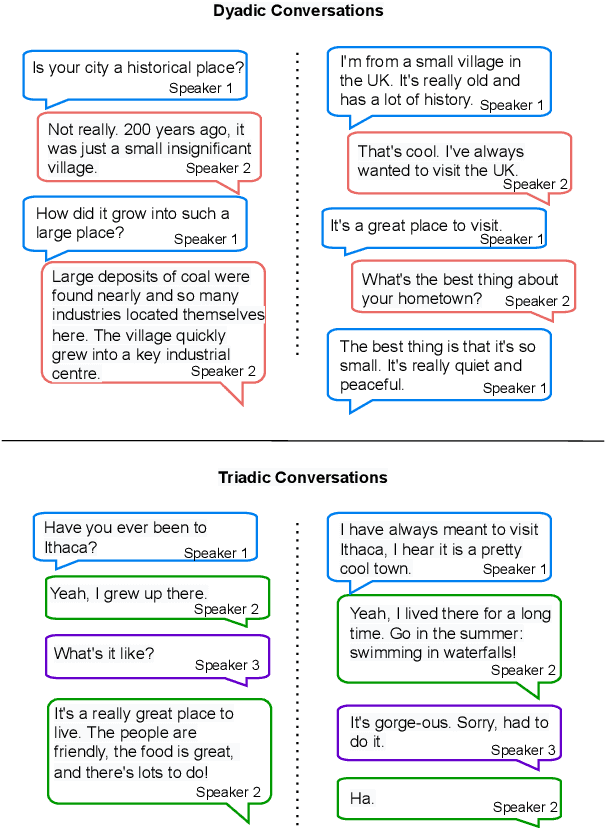
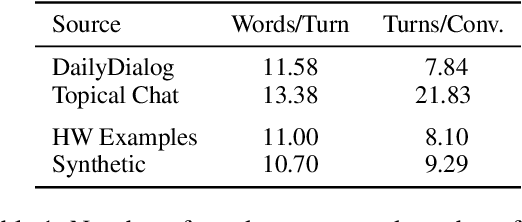
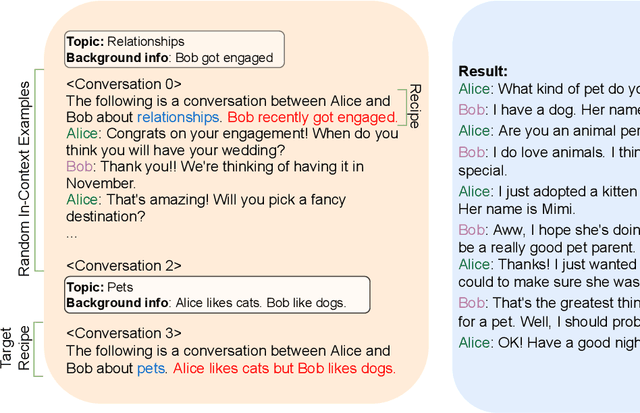
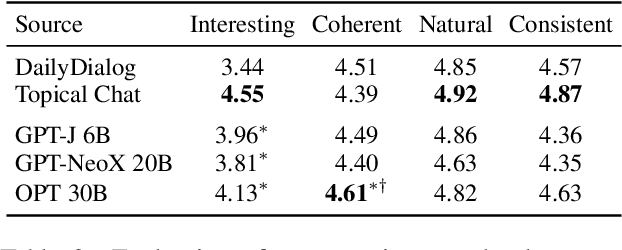
Abstract:Collecting high quality conversational data can be very expensive for most applications and infeasible for others due to privacy, ethical, or similar concerns. A promising direction to tackle this problem is to generate synthetic dialogues by prompting large language models. In this work, we use a small set of expert-written conversations as in-context examples to synthesize a social conversation dataset using prompting. We perform several thorough evaluations of our synthetic conversations compared to human-collected conversations. This includes various dimensions of conversation quality with human evaluation directly on the synthesized conversations, and interactive human evaluation of chatbots fine-tuned on the synthetically generated dataset. We additionally demonstrate that this prompting approach is generalizable to multi-party conversations, providing potential to create new synthetic data for multi-party tasks. Our synthetic multi-party conversations were rated more favorably across all measured dimensions compared to conversation excerpts sampled from a human-collected multi-party dataset.
Weakly Supervised Data Augmentation Through Prompting for Dialogue Understanding
Nov 02, 2022



Abstract:Dialogue understanding tasks often necessitate abundant annotated data to achieve good performance and that presents challenges in low-resource settings. To alleviate this barrier, we explore few-shot data augmentation for dialogue understanding by prompting large pre-trained language models and present a novel approach that iterates on augmentation quality by applying weakly-supervised filters. We evaluate our methods on the emotion and act classification tasks in DailyDialog and the intent classification task in Facebook Multilingual Task-Oriented Dialogue. Models fine-tuned on our augmented data mixed with few-shot ground truth data are able to approach or surpass existing state-of-the-art performance on both datasets. For DailyDialog specifically, using 10% of the ground truth data we outperform the current state-of-the-art model which uses 100% of the data.
CLASP: Few-Shot Cross-Lingual Data Augmentation for Semantic Parsing
Oct 14, 2022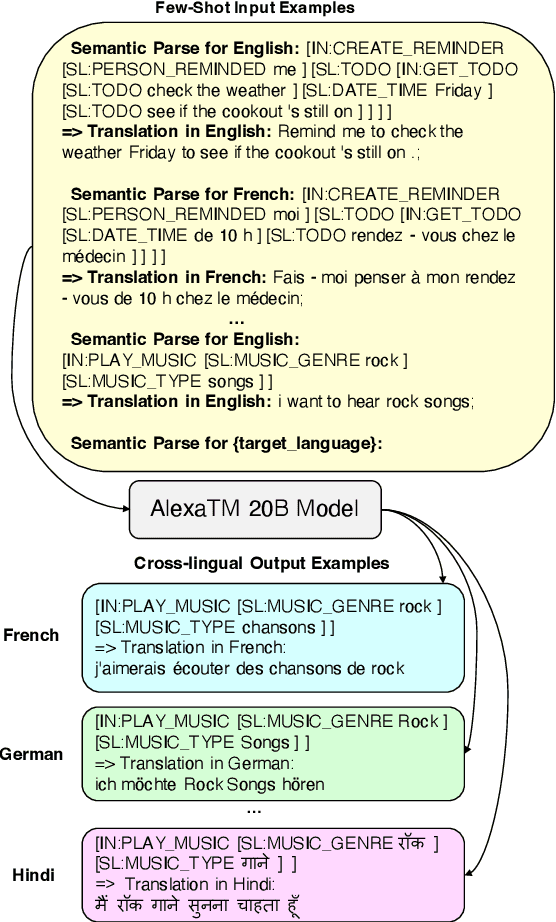
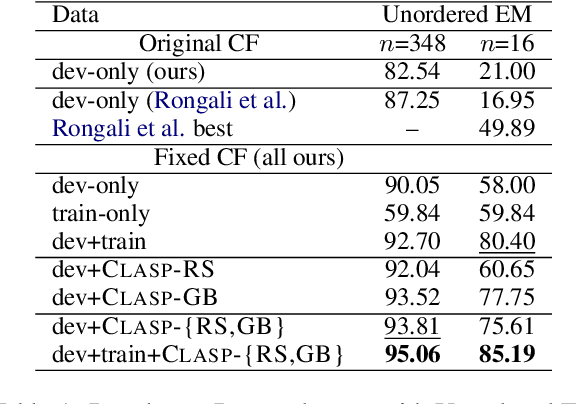

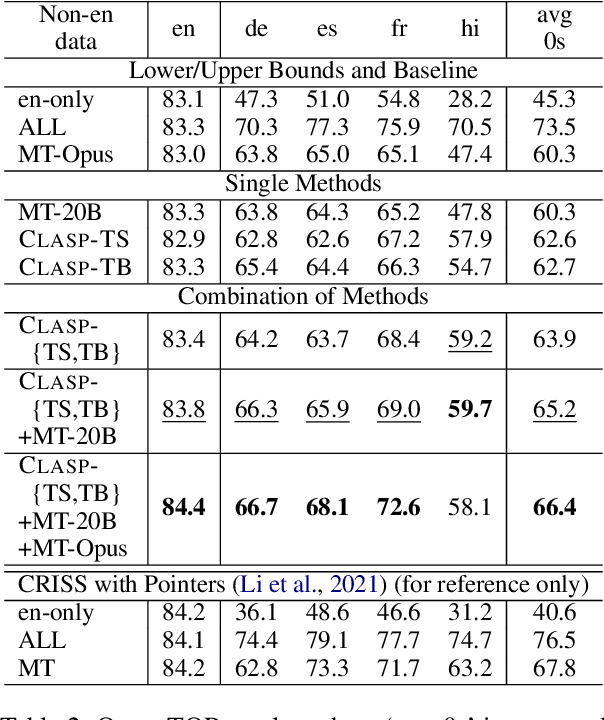
Abstract:A bottleneck to developing Semantic Parsing (SP) models is the need for a large volume of human-labeled training data. Given the complexity and cost of human annotation for SP, labeled data is often scarce, particularly in multilingual settings. Large Language Models (LLMs) excel at SP given only a few examples, however LLMs are unsuitable for runtime systems which require low latency. In this work, we propose CLASP, a simple method to improve low-resource SP for moderate-sized models: we generate synthetic data from AlexaTM 20B to augment the training set for a model 40x smaller (500M parameters). We evaluate on two datasets in low-resource settings: English PIZZA, containing either 348 or 16 real examples, and mTOP cross-lingual zero-shot, where training data is available only in English, and the model must generalize to four new languages. On both datasets, we show significant improvements over strong baseline methods.
LINGUIST: Language Model Instruction Tuning to Generate Annotated Utterances for Intent Classification and Slot Tagging
Sep 20, 2022
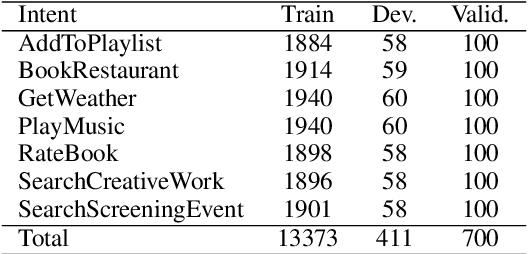
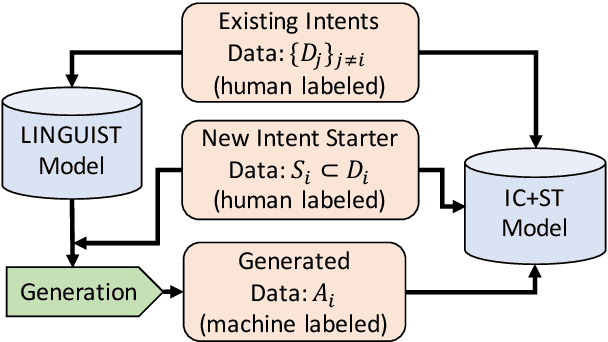
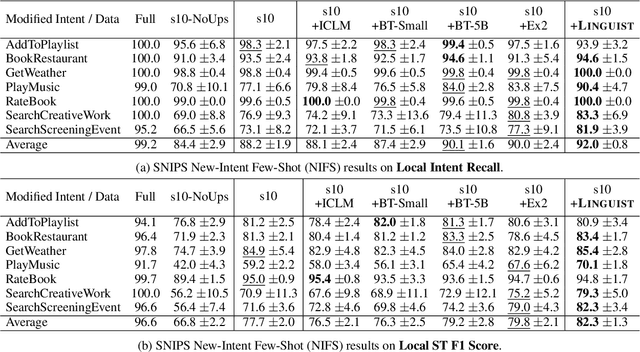
Abstract:We present LINGUIST, a method for generating annotated data for Intent Classification and Slot Tagging (IC+ST), via fine-tuning AlexaTM 5B, a 5-billion-parameter multilingual sequence-to-sequence (seq2seq) model, on a flexible instruction prompt. In a 10-shot novel intent setting for the SNIPS dataset, LINGUIST surpasses state-of-the-art approaches (Back-Translation and Example Extrapolation) by a wide margin, showing absolute improvement for the target intents of +1.9 points on IC Recall and +2.5 points on ST F1 Score. In the zero-shot cross-lingual setting of the mATIS++ dataset, LINGUIST out-performs a strong baseline of Machine Translation with Slot Alignment by +4.14 points absolute on ST F1 Score across 6 languages, while matching performance on IC. Finally, we verify our results on an internal large-scale multilingual dataset for conversational agent IC+ST and show significant improvements over a baseline which uses Back-Translation, Paraphrasing and Slot Catalog Resampling. To our knowledge, we are the first to demonstrate instruction fine-tuning of a large-scale seq2seq model to control the outputs of multilingual intent- and slot-labeled data generation.
AlexaTM 20B: Few-Shot Learning Using a Large-Scale Multilingual Seq2Seq Model
Aug 03, 2022



Abstract:In this work, we demonstrate that multilingual large-scale sequence-to-sequence (seq2seq) models, pre-trained on a mixture of denoising and Causal Language Modeling (CLM) tasks, are more efficient few-shot learners than decoder-only models on various tasks. In particular, we train a 20 billion parameter multilingual seq2seq model called Alexa Teacher Model (AlexaTM 20B) and show that it achieves state-of-the-art (SOTA) performance on 1-shot summarization tasks, outperforming a much larger 540B PaLM decoder model. AlexaTM 20B also achieves SOTA in 1-shot machine translation, especially for low-resource languages, across almost all language pairs supported by the model (Arabic, English, French, German, Hindi, Italian, Japanese, Marathi, Portuguese, Spanish, Tamil, and Telugu) on Flores-101 dataset. We also show in zero-shot setting, AlexaTM 20B outperforms GPT3 (175B) on SuperGLUE and SQuADv2 datasets and provides SOTA performance on multilingual tasks such as XNLI, XCOPA, Paws-X, and XWinograd. Overall, our results present a compelling case for seq2seq models as a powerful alternative to decoder-only models for Large-scale Language Model (LLM) training.
Alexa Teacher Model: Pretraining and Distilling Multi-Billion-Parameter Encoders for Natural Language Understanding Systems
Jun 15, 2022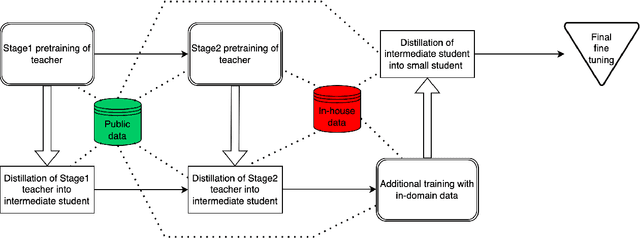
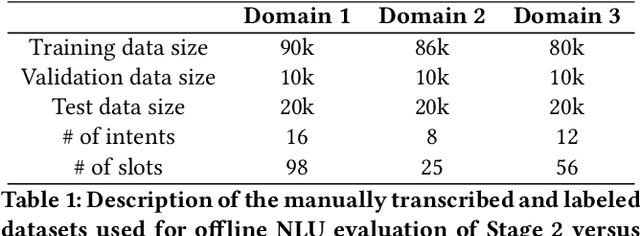
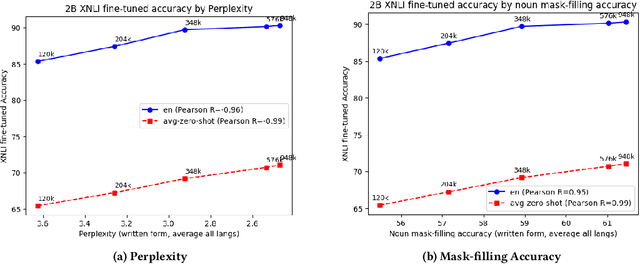
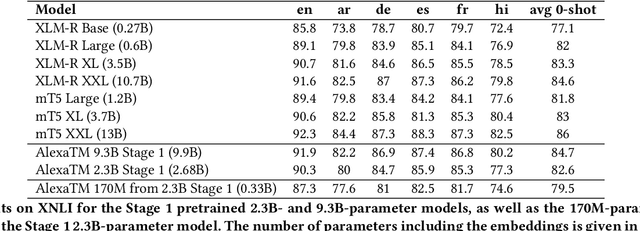
Abstract:We present results from a large-scale experiment on pretraining encoders with non-embedding parameter counts ranging from 700M to 9.3B, their subsequent distillation into smaller models ranging from 17M-170M parameters, and their application to the Natural Language Understanding (NLU) component of a virtual assistant system. Though we train using 70% spoken-form data, our teacher models perform comparably to XLM-R and mT5 when evaluated on the written-form Cross-lingual Natural Language Inference (XNLI) corpus. We perform a second stage of pretraining on our teacher models using in-domain data from our system, improving error rates by 3.86% relative for intent classification and 7.01% relative for slot filling. We find that even a 170M-parameter model distilled from our Stage 2 teacher model has 2.88% better intent classification and 7.69% better slot filling error rates when compared to the 2.3B-parameter teacher trained only on public data (Stage 1), emphasizing the importance of in-domain data for pretraining. When evaluated offline using labeled NLU data, our 17M-parameter Stage 2 distilled model outperforms both XLM-R Base (85M params) and DistillBERT (42M params) by 4.23% to 6.14%, respectively. Finally, we present results from a full virtual assistant experimentation platform, where we find that models trained using our pretraining and distillation pipeline outperform models distilled from 85M-parameter teachers by 3.74%-4.91% on an automatic measurement of full-system user dissatisfaction.
* KDD 2022
 Add to Chrome
Add to Chrome Add to Firefox
Add to Firefox Add to Edge
Add to Edge